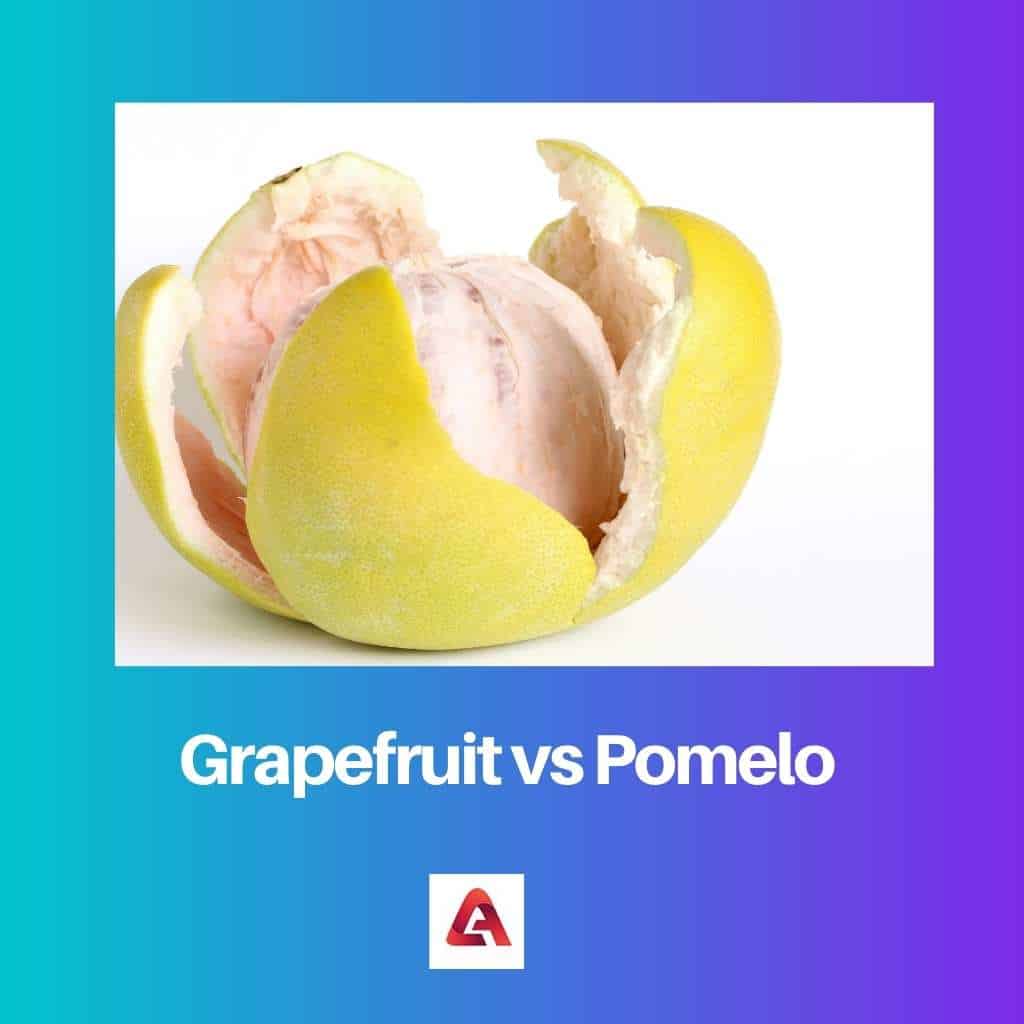Citrus fruits are rich in Vitamin C, fiber, and antioxidants. There are various types of citrus fruits available in the market. Each type has a distinct size, shape, taste, and smell.
The two most common citrus fruits which even seem similar are grapefruit and pomelo.
Key Takeaways
- Grapefruit is a citrus fruit with a tart flavor and a smaller size, while pomelo is a larger citrus fruit with a sweeter, milder taste.
- Grapefruit is a hybrid of pomelo and sweet orange, while pomelo is an original citrus species.
- Grapefruits have thinner peels and are more widely available in supermarkets, while pomelos have thicker peels and are less common in some regions.
Grapefruit vs Pomelo
A Grapefruit is a citrus fruit which is a hybrid between pomelo and sweet orange. It has a yellow or pinkish-yellow skin and pink or red flesh. Pomelos are the largest citrus fruits, with a thick, greenish-yellow skin and pale flesh that is sometimes pink or red and have less acidity.

The growing pattern of grapefruit is in clusters on the tree. Grapefruits are larger than most citrus fruits like lemons and oranges but smaller than pomelo. The skin of grapefruit has shades from reddish to bright yellow.
The skin is smooth and does not have pits.
While the growing pattern of pomelo is it singly hangs on the tree. Pomelo is the largest fruit among the segment of citrus fruits. The skin of pomelo has shades from orange to yellowish-green and even pale yellow.
The skin is rough and is pitted with tiny green spots.
Comparison Table
| Parameters of Comparison | Grapefruit | Pomelo |
|---|---|---|
| Scientific name | Citrus × Paradisi | Citrus grandis or Citrus maxima |
| Purity type | Hybrid | Non-hybrid |
| Size | Smaller in size | Comparatively larger in size |
| Sweetness | Bitter and comparatively less sweet | Sweeter than grapefruits |
| Place of origin | Caribbean island of Barbados | Southeast Asia |
What is Grapefruit?
Grapefruit is a type of subtropical citrus tree. It produces huge, sour to semi-sweet fruit which can also be bitter sometimes. The interior of the fruit is segmented and has a pale yellow to dark pink color.
The origin of grapefruit is in Barbados. Grapefruit is also known as a forbidden fruit. The fruit is a rich source of vitamins A, B, and C.
The binomial name of grapefruit is Citrus × Paradisi. The naming is such because it is a hybrid that has been an accidental cross between sweet orange and shaddock.
The scientific name of both the parent crosses is C. Sinensis and C. maxima. The fruit belongs to the family of Rutaceae. Grapefruit has a low or negligible amount of calories and is a rich source of dietary fiber and protein.
The height of a grapefruit tree is about 5 to 6 meters. Some trees can even grow up to the height of 14 to 15 meters. The tree has distinctive leaves which are long, glossy, and are a dark green color.
The white flowers produced from a grapefruit tree are four-petaled and are two inches in size. The shape of grapefruit is of oblate spheroid and has a distinct skin of yellow-orange color.
The diameter of grapefruit is around 10 to 15 cm. The flesh is of segmented type and the nature is acidic. The patent of the first grapefruit has been granted to Ruby Red by the US in the year 1929.
Grapefruit was also referred to as the “forbidden fruit”. The other common varieties of grapefruit are Marsh, Duncan, Star Ruby, Flame, Walters, Henderson, White Marsh, Rio Star, Triumph, Pummelo HB, Ray, and others.

What is Pomelo?
Pomelo is a type of citrus fruit that belongs to the family of Rutaceae. The scientific name of the fruit is Citrus grandis and even Citrus maxima. The fruit is also known as pummelo.
The fruit is a native of Southeast Asia. It is non-hybrid citrus and is also referred to as the primary ancestor of grapefruit. The consumption of pomelo was mainly during festive occasions in Asia.
Pomelo has shown potential for interaction with drugs. Pomelo was originally known as shaddock.
The naming was done after Captain Shaddock who had introduced the fruit to Barbados and belonged to the East India Company.
The taste of pomelo has a common bitterness which is found in most citrus fruits.
The size of a pomelo tree is around 6 to 15 meters in height. The branches are irregular and low-hanging. The tree has characteristic leaf petioles which are winged and has shapes like ovate and elliptic.
The leaves have a hairy underleaf and leathery green upper layer. The yellow or white flowers produced from the pomelo tree are either single or in clusters and have fragrance.
The juice of pomelo is considered delicious as well as healthy. The rind of the fruit is candied and made preserves.
In various parts of the world like Brazil, the skin of pomelo is utilized in making a conserve that is sweet and the spongy pith produced from the rind is rejected.
The fruit is the largest in the citrus family which belongs to Rutaceae.

Main Differences Between Grapefruit and Pomelo
- The skin color of grapefruit is a mixture of yellow-orange or bright orange while the skin color of pomelo is pale orange, yellow, or even green.
- The skin of grapefruits is rougher while pomelo skin is less rough.
- The popularity of grapefruits is more while the popularity of pomelo is comparatively less in different parts of the world.
- The taste of grapefruit is strong while the taste of pomelo is mild.
- The shape of grapefruits is rounder while the shape of pomelos is like teardrops and resembles pears.
- The peel of grapefruit is thin and soft while the peel of pomelo is thick.

- https://ascpt.onlinelibrary.wiley.com/doi/abs/10.1016/j.clpt.2005.11.010
- https://www.sciencedirect.com/science/article/pii/B9781845697341500212
